the place where Paleontology and Paleoanthropology meets Philately
The Ross Dependency (New Zealand)
Contributors to Paleontological Science on stamps of the Ross Dependency
| << previous country | back to index | next country >> |
Contents:
- Country overview
- Philately of the Ross Dependency
- Some stamps of the Ross Dependency to consider
- References
- Acknowledgements
The Ross Dependency is a region of Antarctica defined by a sector originating at the South Pole, passing along longitudes 160° east to 150° west, and terminating at latitude 60° south.
It is claimed by New Zealand.
Since the Antarctic Treaty came into force in 1961, Article IV of which states: "No acts or activities taking place while the present Treaty is in force shall constitute a basis for asserting, supporting or denying a claim to territorial sovereignty in Antarctica or create any rights of sovereignty in Antarctica", most countries do not recognise territorial claims in Antarctica.
The Dependency takes its name from Sir James Clark Ross, who discovered the Ross Sea, and includes part of Victoria Land, and most of the Ross Ice Shelf.
Ross Island, Balleny Islands and the small Scott Island also form part of the Dependency, as does the ice-covered Roosevelt Island. [R1]
Ross Dependency stamps have been issued by New Zealand postal authorities for use on mail from Scott Base since 1957.
The first stamps inscribed Ross Dependency were issued on January 11, 1957, in conjunction with the New Zealand Antarctic Expedition, led by Sir Edmund Hillary (part of the Commonwealth Trans-Antarctic Expedition).
Before the expedition left New Zealand, on 23 November 1956, Hillary had been appointed Ppostmaster.
When the expedition chose the site for Scott Base, a post office was established, initially in a tent. The initial set of stamps (see below) consisted of four stamps, in the denominations 3d, 4d, 8d, and 1s 6d. When New Zealand adopted a decimal currency in 1967, the stamps were reissued in denominations of 2c, 3c, 7c, and 15c (see below).
The post office at Scott Base was closed in 1987 as part of the rationalisation of New Zealand Post. New Zealand Post resumed the issue of stamps inscribed “Ross Dependency” in 1994, “due to local and international demand.” [R2]
Some stamps of the Ross Dependency to consider: contributors to Paleontology science
| 11.01.1957 "Sterling Currency Definitives" [O1] | 10.07.1967 "Decimal Currency Definitives" [O2] | 09.11.1995 "Antarctic Explorer and their ships" [O1] |
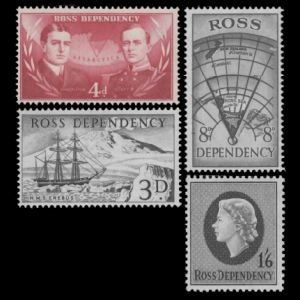 |
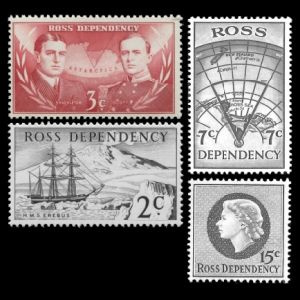 |
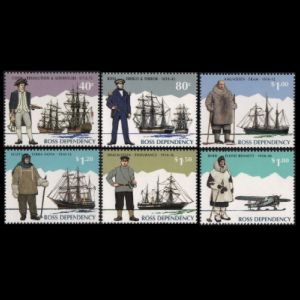 |
| 06.11.2002 "The Discovery Expedition 1901-1904" [O1] | 02.11.2011 "Race to the Pole" [O1] | |
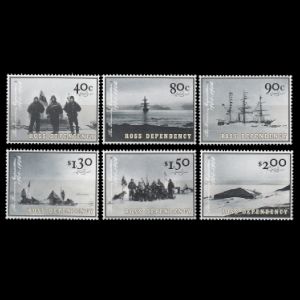 |
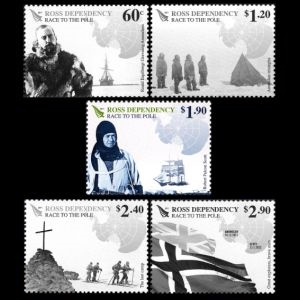 |
|
Notes:
[O1] Robert Falcon Scott was a Royal Navy officer and explorer who led two expeditions to the Antarctic regions: the Discovery expedition of 1901–1904 and the ill-fated Terra Nova expedition of 1910–1912.
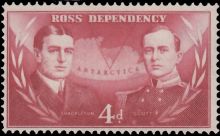 |
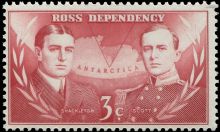 |
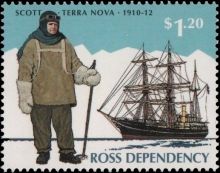 |
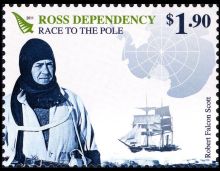 |
|
Robert Falcon Scott on stamps of the Ross Dependency. 1957 MiNr.: 2, Scott: L2; 1967 MiNr.: 6, Scott: L6; 1995 MiNr.: 35, Scott: L34; 2011 MiNr.: 126, Scott: L121; |
|||
Scott and his companions died on the second expedition. When Scott and his party's bodies were discovered, 16kg of Glossopteris (an extinct beech-like tree from 250 million years old) fossils from the Queen Maud Mountains were found next to their bodies, which they had dragged on hand sledges.
These fossils were promised to Marie Stopes (shown on UK stamp in 2008) to provide evidence for Eduard Suess's idea that Antarctica had once been part of an ancient super-continent named Gondwanaland (now Gondwana).
More details are here.
Note: Robert Falcon Scott was honoured on several stamps of the British Antarctic Territory and UK, as well as on several international postmarks. [R3]
[O2] The same design as definitive set from 1957, but with face vakues in different currency.
Decimal currency was introduced to New Zealand on 10 July 1967 - the same day new definitive stamps set was introduced by the Post of New Zealand.
[O3] The stamps from 2011, were printed on separate sheets as well as in several Souvenir Sheets.
References:
- [R1] The Ross Dependency: Wikipedia,
- [R2] Postal History and Philately of the Ross Dependency: Wikipedia.
- [R3] Robert Falcon Scott: Wikipedia, Expeditions fieldmuseum, BBC.
Acknowledgements:
Many thanks to Dr. Peter Voice from Department of Geological and Environmental Sciences, Western Michigan University, for reviewing the draft page and his very valuable comments.
| << previous country | back to index | next country >> |